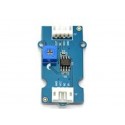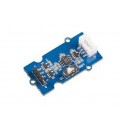Grove Differential Amplifier V1.0
Rs. 377.00 Rs. 453.00
- Brand: https://www.ti.com/product/INA125
- Product Code: SEN-AMP-DIFF
- SKU - SE-2891
- Availability: In Stock
- Price in reward points: 5
- For Bulk Order
 9962060070
9962060070
Quick support on WhatsApp (+919962060070) only between morning 11am-4pm, no call will be answered
SPECIFICATIONS:
| Item | Min | Typical | Max | Unit |
| Operating Voltage | 2.7 | 5.0 | 36 | VDC |
| Input Voltage | 0.1 | \ | (Vcc-0.8)/Gain | m |
| Output Voltage | 0 | \ | Vcc-0.80 | mV |
| Gain Select 304 | 297.92 | 304 | 310.08 | / |
| Select 971 | 951.58 | 971 | 990.42 |
| OVERVIEW: | |
| LOW QUIESCENT CURRENT | 460µA |
| PRECISION VOLTAGE REFERENCE | 1.24V, 2.5V, 5V or 10V |
| SLEEP MODE: | |
| LOW OFFSET VOLTAGE | 250µV max |
| LOW OFFSET DRIFT | 2µV/°C max |
| LOW INPUT BIAS CURRENT | 20nA max |
| HIGH CMR | 100dB min |
| LOW NOISE | 38nV/sqrt(Hz) at f = 1kHz |
| INPUT PROTECTION TO ±40V | |
| WIDE SUPPLY RANGE: | |
| Single Supply | 2.7V to 36V |
| Dual Supply | ±1.35V to ±18V |
PACKAGE INCLUDES:
1 PCS x Grove Differential Amplifier V1.0
https://www.ti.com/product/INA125
//SOURCE CODE TAKEN FROM BELOW LINK
//https://forum.arduino.cc/index.php?topic=286899.0
// Arduino as load cell amplifier
// by Christian Liljedahl
// christian.liljedahl.dk
// Load cells are linear. So once you have established two data pairs, you can interpolate the rest.
// Step 1: Upload this sketch to your arduino board
// You need two loads of well know weight. In this example A = 10 kg. B = 30 kg
// Put on load A
// read the analog value showing (this is analogvalA)
// put on load B
// read the analog value B
// Enter you own analog values here
float loadA = 10; // kg
int analogvalA = 200; // analog reading taken with load A on the load cell
float loadB = 30; // kg
int analogvalB = 600; // analog reading taken with load B on the load cell
// Upload the sketch again, and confirm, that the kilo-reading from the serial output now is correct, using your known loads
float analogValueAverage = 0;
// How often do we do readings?
long time = 0; //
int timeBetweenReadings = 2000; // We want a reading every 200 ms;
void setup() {
Serial.begin(9600);
}
void loop() {
int analogValue = analogRead(0);
// running average - We smooth the readings a little bit
analogValueAverage = 0.99*analogValueAverage + 0.01*analogValue;
// Is it time to print?
if(millis() > time + timeBetweenReadings){
float load = analogToLoad(analogValueAverage);
Serial.print("analogValue: ");Serial.println(analogValueAverage);
Serial.print(" load: ");Serial.println(load,5);
time = millis();
}
}
float analogToLoad(float analogval){
// using a custom map-function, because the standard arduino map function only uses int
float load = mapfloat(analogval, analogvalA, analogvalB, loadA, loadB);
return load;
}
float mapfloat(float x, float in_min, float in_max, float out_min, float out_max)
{
return (x - in_min) * (out_max - out_min) / (in_max - in_min) + out_min;
}
//Reference www.instructables.com/id/Arduino-Load-Cell-Scale/step3/The-Code/
15 days



